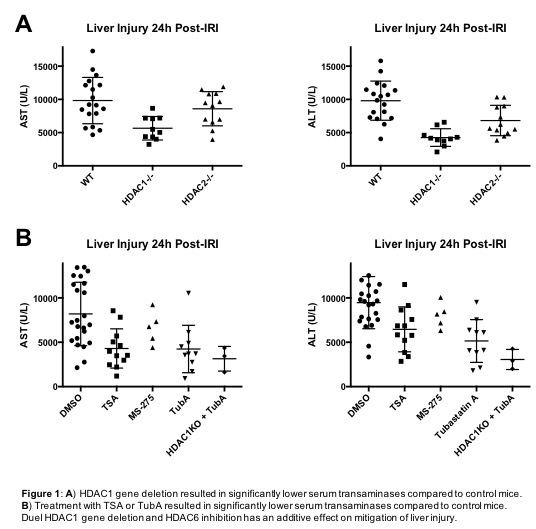Histone Deacetylase Inhibition Mitigates Liver Ischemia/Reperfusion Injury in Mice.
1Surgery, Hospital of the University of Pennsylvania, Philadelphia, PA
2Pathology and Laboratory Medicine, Children's Hospital of Philadelphia, Philadelphia, PA
Meeting: 2017 American Transplant Congress
Abstract number: B123
Keywords: Ischemia, Liver, Liver transplantation, Warm ischemia
Session Information
Session Name: Poster Session B: Ischemic Injury and Organ Preservation Session II
Session Type: Poster Session
Date: Sunday, April 30, 2017
Session Time: 6:00pm-7:00pm
 Presentation Time: 6:00pm-7:00pm
Presentation Time: 6:00pm-7:00pm
Location: Hall D1
Introduction: Ischemia/reperfusion injury (IRI) causes significant morbidity in liver transplantation and other surgical scenarios. A better understanding of the molecular mechanisms of IRI is required so that strategies for prevention and treatment can be developed. Histone deacetylases (HDACs) regulate diverse cellular processes. We have previously shown protection from renal IRI with pan-HDAC inhibition with trichostatin-A (TSA) and isoform-specific gene deletion of HDAC2. We wished to investigate the effects of HDAC inhibition in liver IRI.
Methods: Wild type C57BL/6 (WT), tamoxifen-treated WT controls, whole-body HDAC1 deficient (HDAC1-/-), and whole-body HDAC2 deficient (HDAC2-/-) male mice were used. Select mice were treated with TSA, the class I HDAC inhibitor MS-275, the HDAC6 inhibitor Tubastatin-A (TubA), or DMSO at 16 and 1 hours pre-IRI. Mice were subjected to 70% liver ischemia for 60 minutes under strict temperature control with assessment of plasma concentrations of AST and ALT at 24 hours post-injury. Liver tissue was harvested for histopathology at 48 hours post-injury.
Results: HDAC1-/- mice developed significantly less injury after IRI compared to control mice as measured by serum AST (p<0.01) and ALT (p<0.001) (Figure 1A). TSA- and TubA-treated WT mice developed significantly less hepatocellular injury after liver IRI than control mice as measured by serum AST (p<0.05) and ALT (p<0.05). TubA-treated HDAC1-/- mice demonstrated further protection from hepatic IRI compared to both TubA-treated WT and HDAC1-/- mice (p<0.05) (Figure 1B). Conclusion: Pan-HDAC inhibition mitigates liver injury after hepatic IRI in mice. Selective inhibition of HDAC1 via inducible gene deletion and selective pharmacologic inhibition of HDAC6 with TubA both replicate this protection and also have an additive benefit. These findings are distinct from the pattern of HDAC involvement in renal IRI and suggest tissue-specific roles for HDACs in IRI response, which has implications for therapeutic intervention.
Conclusion: Pan-HDAC inhibition mitigates liver injury after hepatic IRI in mice. Selective inhibition of HDAC1 via inducible gene deletion and selective pharmacologic inhibition of HDAC6 with TubA both replicate this protection and also have an additive benefit. These findings are distinct from the pattern of HDAC involvement in renal IRI and suggest tissue-specific roles for HDACs in IRI response, which has implications for therapeutic intervention.
CITATION INFORMATION: Murken D, Aufhauser Jr D, Concors S, Wang Z, Ge G, Hancock W, Levine M. Histone Deacetylase Inhibition Mitigates Liver Ischemia/Reperfusion Injury in Mice. Am J Transplant. 2017;17 (suppl 3).
To cite this abstract in AMA style:
Murken D, Jr DAufhauser, Concors S, Wang Z, Ge G, Hancock W, Levine M. Histone Deacetylase Inhibition Mitigates Liver Ischemia/Reperfusion Injury in Mice. [abstract]. Am J Transplant. 2017; 17 (suppl 3). https://atcmeetingabstracts.com/abstract/histone-deacetylase-inhibition-mitigates-liver-ischemiareperfusion-injury-in-mice/. Accessed December 24, 2025.« Back to 2017 American Transplant Congress
